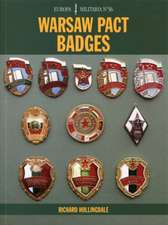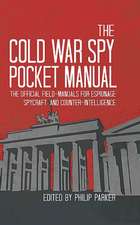Samizdat, Tamizdat, and Beyond: Studies in Contemporary European History
Autor Chrystine Brouillet Editat de Friederike Kind-Kov Cs, Jessie Laboven Limba Engleză Hardback – 14 mar 2013
Din seria Studies in Contemporary European History
-
 Preț: 224.19 lei
Preț: 224.19 lei -
 Preț: 218.99 lei
Preț: 218.99 lei - 23%
 Preț: 751.71 lei
Preț: 751.71 lei - 23%
 Preț: 751.71 lei
Preț: 751.71 lei -
 Preț: 346.49 lei
Preț: 346.49 lei - 23%
 Preț: 750.08 lei
Preț: 750.08 lei - 23%
 Preț: 836.52 lei
Preț: 836.52 lei -
 Preț: 301.20 lei
Preț: 301.20 lei -
 Preț: 300.83 lei
Preț: 300.83 lei -
 Preț: 263.33 lei
Preț: 263.33 lei -
 Preț: 262.52 lei
Preț: 262.52 lei - 23%
 Preț: 747.99 lei
Preț: 747.99 lei - 23%
 Preț: 751.08 lei
Preț: 751.08 lei -
 Preț: 300.83 lei
Preț: 300.83 lei -
 Preț: 263.58 lei
Preț: 263.58 lei -
 Preț: 261.63 lei
Preț: 261.63 lei - 23%
 Preț: 808.91 lei
Preț: 808.91 lei - 23%
 Preț: 747.25 lei
Preț: 747.25 lei -
 Preț: 155.80 lei
Preț: 155.80 lei - 23%
 Preț: 753.76 lei
Preț: 753.76 lei
Preț: 835.18 lei
Preț vechi: 1084.65 lei
-23% Nou
Puncte Express: 1253
Preț estimativ în valută:
159.83€ • 166.25$ • 131.95£
159.83€ • 166.25$ • 131.95£
Carte tipărită la comandă
Livrare economică 14-28 aprilie
Preluare comenzi: 021 569.72.76
Specificații
ISBN-13: 9780857455857
ISBN-10: 0857455850
Pagini: 380
Dimensiuni: 158 x 237 x 26 mm
Greutate: 0.66 kg
Editura: BERGHAHN BOOKS INC
Seria Studies in Contemporary European History
ISBN-10: 0857455850
Pagini: 380
Dimensiuni: 158 x 237 x 26 mm
Greutate: 0.66 kg
Editura: BERGHAHN BOOKS INC
Seria Studies in Contemporary European History
Notă biografică
Friederike Kind-KovA¡cs is Assistant Professor in the Department of Southeast and East European History at Regensburg University.
Cuprins
List of Illustrations Foreword Acknowledgements Introduction Section I: Producing and Circulating Samizdat/Tamizdat Before 1989 Chapter 1. Ardis Facsimile and Reprint Editions: Giving Back Russian Literature Ann Komaromi Chapter 2. The Baltic Connection: Transnational Networks of Resistance after 1976 Fredrik Lars Stocker Chapter 3. Radio Free Europe and Radio Liberty as the 'Echo Chamber' of Tamizdat Friederike Kind-Kovacs Chapter 4. Contact Beyond Borders and Historical Problems: Kultura, Russian Emigration and the Polish Opposition Karolina Ziolo-Puzuk Section II: Diffusing Non-Conformist Ideas Through Samizdat/Tamizdat Before 1989 Chapter 5. "Free Conversations in an Occupied Country:" Cultural Transfer, Social Networking and Political Dissent in Romanian Tamizdat Cristina Petrescu Chapter 6. The Danger of Over-Interpreting Dissident Writing in the West: Communist Terror in Czechoslovakia, 1948-1968 Muriel Blaive Chapter 7. Renaissance or Reconstruction? Intellectual Transfer of Civil Society Discourses Between Eastern and Western Europe Agnes Arndt Section III: Transforming Modes and Practices of Alternative Culture Chapter 8. The Bards of Magnitizdat: An Aesthetic Political History of Russian Underground Recordings Brian A. Horne Chapter 9. Writing about apparently non-existent art: the tamizdat journal A-Ja and Russian unofficial arts in the 1970s-1980s Valentina Parisi Chapter 10. "Video Knows No Borders": Samizdat Television and the Unofficial Public Sphere in "Normalized" Czechoslovakia Alice Lovejoy Section IV: Moving From Samizdat/Tamizdat To Alternative Media Today Chapter 11. Postprintium? Digital literary samizdat on the Russian Internet Henrike Schmidt Chapter 12. Independent Media, Transnational Borders, and Networks of Resistance: Collaborative Art Radio between Belgrade (Radio B92) and Vienna (ORF) Daniel Gilfillan Chapter 13. "From Wallpapers to Blogs": Samizdat and Internet in China Martin Hala Chapter 14. Reflections on the Revolutions in Europe: Lessons for the Middle East and the Arab Spring Barbara J. Falk Afterword Jacques Rupnik Selected Bibliography Notes on Contributors
Recenzii
"Samizdat, Tamizdat, and Beyond offers a long awaited rethinking of dissent at the grassroots level. Looking primarily but not exclusively to the Eastern Bloc, this volume skillfully stretches our understanding of samizdat to incorporate visual art, music, video, and the web. The editors bring together seemingly disparate samizdat 'texts' by placing them within the larger context of transnationalism, gender, and mass media. In so doing, they remind us that dissent is, first and foremost, a creative human endeavor; one that not only has a history but also a future." * Paulina Bren, Vassar College "The information and insights contained in this volume fill the gap in our knowledge about the vitality, diversity, and ongoing relevance of samizdat/tamizdat and alternative media not only in the post-Communist states represented here, but in emerging democracies in other regions of the world, e.g. the Middle East and Asia." * Michael Long, Baylor University










